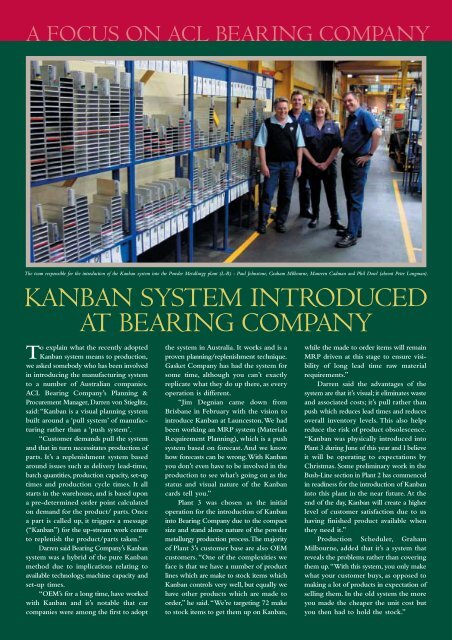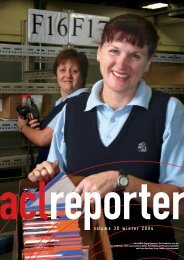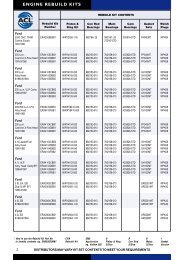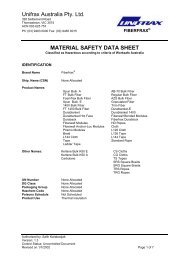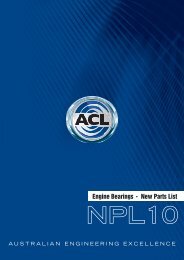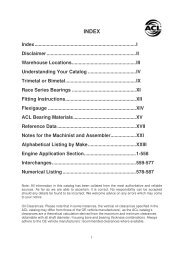ACL Newsletter Issue 28
ACL Newsletter Issue 28
ACL Newsletter Issue 28
- No tags were found...
Create successful ePaper yourself
Turn your PDF publications into a flip-book with our unique Google optimized e-Paper software.
A FOCUS ON <strong>ACL</strong> BEARING COMPANY<br />
The team responsible for the introduction of the Kanban system into the Powder Metallurgy plant (L-R) - Paul Johnstone, Graham Milbourne, Maureen Cadman and Phil Dowl (absent Peter Longman).<br />
KANBAN SYSTEM INTRODUCED<br />
AT BEARING COMPANY<br />
To explain what the recently adopted<br />
Kanban system means to production,<br />
we asked somebody who has been involved<br />
in introducing the manufacturing system<br />
to a number of Australian companies.<br />
<strong>ACL</strong> Bearing Company’s Planning &<br />
Procurement Manager, Darren von Stieglitz,<br />
said:“Kanban is a visual planning system<br />
built around a ‘pull system’ of manufacturing<br />
rather than a ‘push system’.<br />
“Customer demands pull the system<br />
and that in turn necessitates production of<br />
parts. It’s a replenishment system based<br />
around issues such as delivery lead-time,<br />
batch quantities, production capacity, set-up<br />
times and production cycle times. It all<br />
starts in the warehouse, and is based upon<br />
a pre-determined order point calculated<br />
on demand for the product/ parts. Once<br />
a part is called up, it triggers a message<br />
(“Kanban”) for the up-stream work centre<br />
to replenish the product/parts taken.”<br />
Darren said Bearing Company’s Kanban<br />
system was a hybrid of the pure Kanban<br />
method due to implications relating to<br />
available technology, machine capacity and<br />
set-up times.<br />
“OEM’s for a long time, have worked<br />
with Kanban and it’s notable that car<br />
companies were among the first to adopt<br />
the system in Australia. It works and is a<br />
proven planning/replenishment technique.<br />
Gasket Company has had the system for<br />
some time, although you can’t exactly<br />
replicate what they do up there, as every<br />
operation is different.<br />
“Jim Degnian came down from<br />
Brisbane in February with the vision to<br />
introduce Kanban at Launceston.We had<br />
been working an MRP system (Materials<br />
Requirement Planning), which is a push<br />
system based on forecast. And we know<br />
how forecasts can be wrong.With Kanban<br />
you don’t even have to be involved in the<br />
production to see what’s going on as the<br />
status and visual nature of the Kanban<br />
cards tell you.”<br />
Plant 3 was chosen as the initial<br />
operation for the introduction of Kanban<br />
into Bearing Company due to the compact<br />
size and stand alone nature of the powder<br />
metallurgy production process.The majority<br />
of Plant 3’s customer base are also OEM<br />
customers. “One of the complexities we<br />
face is that we have a number of product<br />
lines which are make to stock items which<br />
Kanban controls very well, but equally we<br />
have other products which are made to<br />
order,” he said.“We’re targeting 72 make<br />
to stock items to get them up on Kanban,<br />
while the made to order items will remain<br />
MRP driven at this stage to ensure visibility<br />
of long lead time raw material<br />
requirements.”<br />
Darren said the advantages of the<br />
system are that it’s visual; it eliminates waste<br />
and associated costs; it’s pull rather than<br />
push which reduces lead times and reduces<br />
overall inventory levels. This also helps<br />
reduce the risk of product obsolescence.<br />
“Kanban was physically introduced into<br />
Plant 3 during June of this year and I believe<br />
it will be operating to expectations by<br />
Christmas. Some preliminary work in the<br />
Bush-Line section in Plant 2 has commenced<br />
in readiness for the introduction of Kanban<br />
into this plant in the near future. At the<br />
end of the day, Kanban will create a higher<br />
level of customer satisfaction due to us<br />
having finished product available when<br />
they need it.”<br />
Production Scheduler, Graham<br />
Milbourne, added that it’s a system that<br />
reveals the problems rather than covering<br />
them up.“With this system, you only make<br />
what your customer buys, as opposed to<br />
making a lot of products in expectation of<br />
selling them. In the old system the more<br />
you made the cheaper the unit cost but<br />
you then had to hold the stock.”


